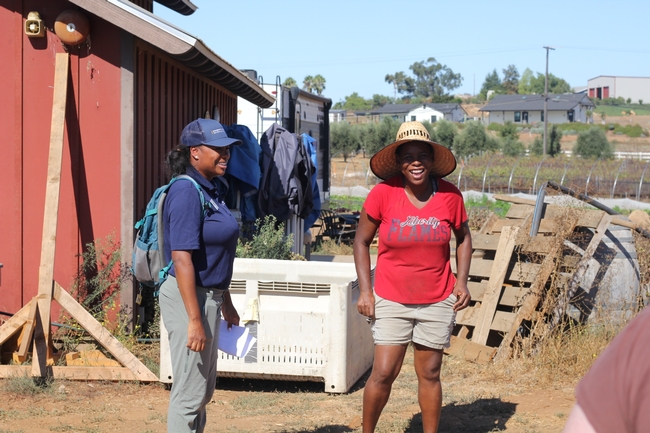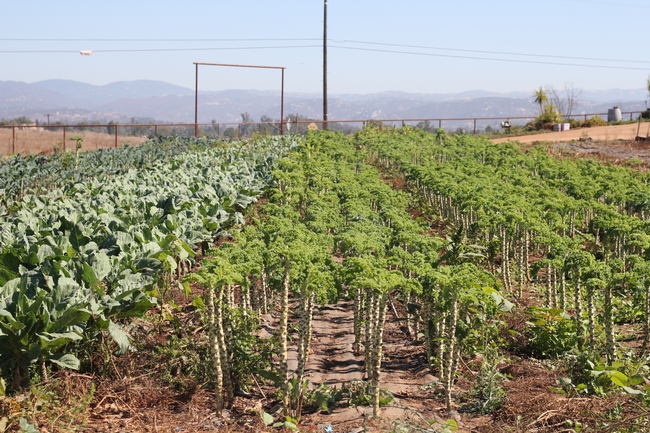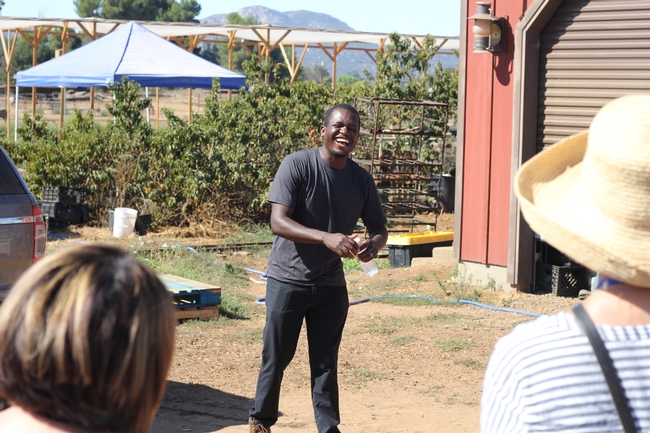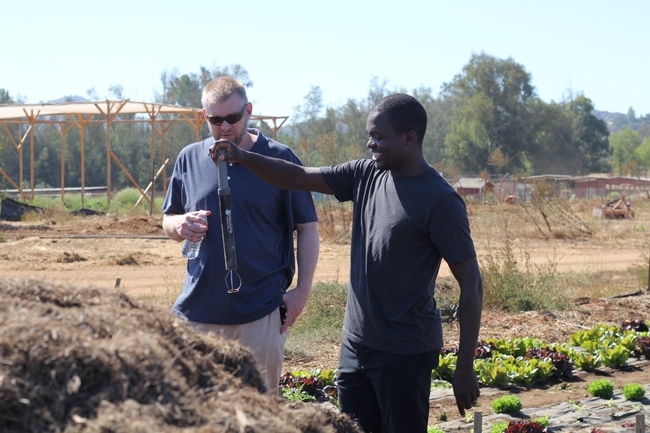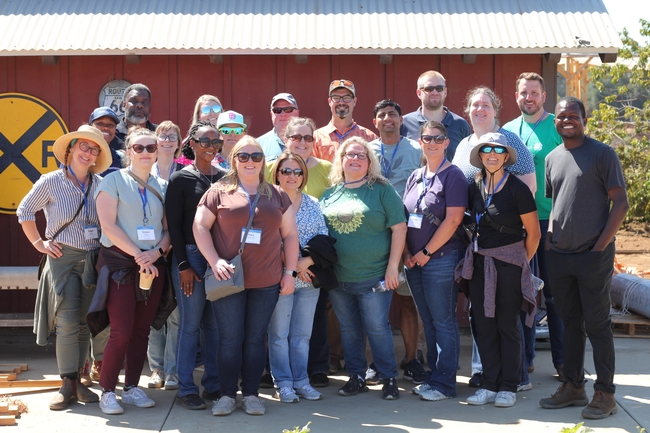Posts Tagged: FOOD IT
South Coast REC program educates, trains future ag workforce
GROW program also builds skills of students with learning differences
Renowned for pioneering research that leads to exciting new crop varieties like the Luna avocado, the University of California South Coast Research and Extension Center (REC) in Irvine is also an important hub for agricultural education. Through programs like the GROW program, South Coast REC – administered by UC Agriculture and Natural Resources – is a dynamic resource for workforce development in the community.
Originally created by the Orange County Farm Bureau, GROW provides out-of-the-classroom experiences in agri-business, career exploration and other educational opportunities for local high students in school districts with agriculture programs. Participants engage in field days at South Coast REC to learn about the research component of agriculture, and the research center quickly became a popular aspect of the program.
In 2016, South Coast REC stepped in to oversee GROW. Tammy Majcherek, UC Cooperative Extension community education specialist for Orange County, has been at the forefront of the program's successful partnership between the Orange County Farm Bureau and the REC.
“Each field day we host is different, and that's intentional,” said Majcherek. “The students aren't just learning about agriculture – they're experiencing it. During their visit, they see where their food comes from and realize that agriculture isn't just planting seeds or hopping on a tractor.”
In 2023, GROW reached more than 600 high school students and continues to nourish the minds and lives of Orange County community members. Students interact with UCCE advisors, industry partners and other experts to learn about a wide variety of topics related to agriculture including hydroponics and emerging ag technologies, pest management, food safety and preservation, plant breeding and more.
Andres Martinez, a junior at Fullerton Joint Union High School in Orange County, recently visited South Coast REC for a GROW field day and said it surpassed his expectations. "Everything was cool. I thought we were just going to be sitting in a classroom but my expectations definitely got blown out the water," he said, adding that he loves to eat and his favorite part of the visit was trying new food.
Martinez admitted that the visit deepened his interest in agriculture and he would like to return to South Coast REC to learn more about where his food comes from.
Chocolate avocado pudding, anyone?
“We provide an opportunity for the students to see how growers, nutritionists and chefs intersect,” Majcherek said, noting that participants not only get to taste the crops harvested at South Coast REC, but they get to use it in creative dishes like chocolate avocado pudding.
Using cocoa powder, avocados, milk or milk alternatives and a sweetener, participants create a new and different snack. Thy Phan, a student at Westminster High School, recently visited South Coast REC for a GROW field day and said the pudding taste surprised her. “It didn't look that good when we were making it, but I actually like it,” she said.
“Of course, not all the students are going to like it but many of them are, at least, willing to try something new because they're involved in the process of creating it,” said Majcherek.
Jacob Ortigoza, another student from Westminster High School, confirmed that he was not a fan of the chocolate avocado pudding. “I didn't like the flavor, but making it was fun. I'd like to do more cooking,” he said.
GROW continues to expand its programming to serve students in various Career Technical Education programs, including cuisine, biology and mechanical engineering, as well as young adults in Adult Transition Programs.
GROW participants enter the workforce at SCREC
Adult Transition Programs (ATP) cater to 18- to 26-year-olds who have learning differences and are shifting from the student life to that of a young professional. Skill-building, for personal or professional use, is the primary focus of ATP and Majcherek was adamant about providing a space for ATP members to learn and explore at South Coast REC.
Gavin Olsen, who was a member of ATP at Esperanza Education Center in Mission Viejo, also learned of South Coast REC during a GROW field day. Despite growing up in Orange County, Olsen admitted that he had no idea the REC existed, but is glad he finally does.
“I grew up knowing about agriculture and come from a family of farmers,” said Olsen, who dreams of owning land one day. “At South Coast, I'm learning what it takes to manage land and I'm understanding plants better,” he added.
Lindsey Pedroncelli, interim director of South Coast REC, envisions the center as a launch pad for success. “We not only want to highlight novel career paths to students, but we want to train and empower them to work in these spaces,” she said.
Earlier this year, Olsen was hired as a field technician, supporting matters like plowing weeds, setting up irrigation lines and preparing field plots. Olsen has dyslexia and said the nature of his work at South Coast REC requires him to be hands-on, which he loves and prefers over desk work.
“I love getting my hands dirty and I feel like the hands-on aspect of the job is the best part,” Olsen said.
Pedroncelli wants South Coast REC to continue serving students by providing a base of knowledge that will help them succeed in the various agricultural industries.
“Beyond teaching the basics, we aim to assist students in taking the next step – whether that be pursuing a certification or degree at a college or university, taking part in an internship, or getting their first industry job,” Pedroncelli added.
To donate and support the GROW program, visit https://give.ucanr.edu/forms/SCREC-GROW.
Students design high-tech solutions through Farm Robotics Challenge
Award-winning teams announced at FIRA USA robotics conference
A robot that navigates and weeds row-crop fields – and its design team from Olin College of Engineering in Massachusetts – have garnered the grand prize in the second annual Farm Robotics Challenge. Five winning teams, representing various universities and colleges across the U.S., were announced on Oct. 24 during a ceremony at the FIRA USA robotics conference in Woodland (watch recording).
A total of nine teams competed in the Farm Robotics Challenge, organized by University of California Agriculture and Natural Resources and the AI Institute for Next Generation Food Systems (AIFS), with support from technology partner farm-ng.
During the yearlong contest, the students engaged with growers about their pain points and challenges and then developed creative solutions using the farm-ng Amiga robot platform.
“It's inspiring to see the creativity and dedication of these students, who put in a lot of hard work and long hours to pull together some truly remarkable projects for this competition,” said Gabriel Youtsey, chief innovation officer at UC ANR. “We hope the challenge attracts more students to consider careers in agriculture; we're here to help build a supportive community to grow that pipeline to the workforce.”
Providing a platform for students to demonstrate innovative design, field testing and evaluation, and real-world problem solving, the Farm Robotics Challenge is sponsored by F3 Innovate, Beck's Hybrids, California Tomato Research Institute and the United Soybean Board.
“It's a great day when engineers, marketing and technology folks understand there are great opportunities to create products for American farmers,” said Brad Fruth, director of innovation at Beck's Hybrids. “It has been exciting for Beck's Hybrids to participate in this challenge and see the bleeding edge of where technology and agriculture converge.”
The student teams leveraged AI, machine learning, automation, coding and fabrication to advance innovation in agriculture.
“Not only does the challenge demonstrate the future of farming with robotics, but it's also encouraging the next generation of engineers to focus their talents on the challenges that exist in growing our food,” said Brendan Dowdle, CEO of farm-ng. “The students who participate have a unique mix of skills in robotics, software and a passion for the future of agriculture.”
Grand Prize Winner: PhoenixBot, Olin College of Engineering, an autonomous mechanical weeding systembuilt to navigate through row-based crop fields of seedling to early-stage crops to effectively remove weeds from the beds
Team Advisor: Kenechukwu Mbanisi
Students:
Summer Crew/Leads: Jeffrey Woodyard, Dokyun Kim, AJ Evans, Toby Mallon, Brooke Moss
Subteam Leads: Dexter Friis-Hecht, Joe Leedy, Maya Adelman, Dominic Salmieri, Chang Jun Park, Akshat Jain
Team Members: Bill Le, Dongim Lee, Felix Halaska, Bhargavi Deshpande, Elisa Camacho, Cooper Penkava, Marcellus Smith, Rohan Bendapudi, Darian Jiminez, Ivy Mahncke, Quinn Verrill, Sam Wisnoski, Oscar Bao, Mia Chevere, Shauna Sperou
Excellence in Productivity: Florabot, Auburn University, a robot designed to autonomously navigate through nursery plant beds collecting imagery data for plant counting and quality assessment
Team Advisor: Tanzeel Rehman
Students: Hamid Syed, Faraz Ahmad, Mesbahul Maruf, Mohtasim Hadi, Carter Freeman
Excellence in Small Farms Technology: Bin Haulers, Washington State University & Heritage University, a precision agricultural robotic system designed for efficient bin-picking and placement in apple orchards
Team Advisors: Manoj Karkee, Safal Kshetri
Students: Dawood Ahmed, Syed Usama Bin Sabir, Divyanth L.G., Priyanka Upadhyaya, Achyut Paudel, Robert Barragan, Apol Medrano, Osmar Alvarez, Bethany Navaroo, Salvador Ayala
Excellence in Sustainability: TAMU-NCSU Robotics Team, Texas A&M University & North Carolina State University, a multi-modal proximal data collection system utilizing artificial intelligence to generate height maps for semi-structured row crop fields to aid in effective application of post-emergence herbicide
Team Advisors: Steven Brian Mirsky, Chris Reberg-Horton, Muthu Bagavathiannan
Students: Joe Johnson, Matthew Kutugata, Ruthvik Kanumuri, Wesley Hawkes, Jonathan Herrera, Luke Conran, Sebastian Chu
Excellence in Safety: University of California Santa Cruz, an application that allows a user to view the camera, as well as operate the Amiga robot, without a physical connection
Team Advisors: Dejan Milutinovic, Darryl Wong
Students: Katherine Rogacheva, Milos Suvakovic, Oliver Fuchs, Sam Leveau, Mauricio Chavez
In addition to recognition for their efforts, the Grand Prize Winner was awarded $10,000, and the Excellence in Productivity and Small Farms Technology winners won $5,000 each, while the Excellence in Sustainability and Safety winners won $2,500 each.
Other competitors in the challenge included teams from Cal Poly San Luis Obispo, California State University Fresno, Hartnell College and The Pennsylvania State University.
For more information about the Farm Robotics Challenge, including details on how to participate, visit https://farmroboticschallenge.ai.
Partners unveil first on-farm robotics incubators
Opening in Salinas and Merced in 2025, Reservoir Farms will drive ag innovations in automation robotics
The Reservoir, a nonprofit building tech incubators across California, and partners Western Growers Association, University of California Agriculture and Natural Resources, Merced College, Hartnell College and venture capital firm HawkTower have announced the creation of the first-ever on-farm robotics incubators, Reservoir Farms.
Unveiled during a press conference at the FIRA USA 2024 robotics conference in Woodland, Reservoir Farms are set to open in the Central and Salinas Valleys in early 2025. This pioneering initiative significantly shifts how agricultural technology innovates through real-world testing environments, world-class resources and critical industry partnerships.
California agriculture faces critical challenges, including labor availability and cost, import competition, increased regulation, water scarcity, and climate-related challenges, including extreme weather. These challenges have spurred significant advancements in agricultural precision, automation, mechanization, and robotics in recent years.
Despite advancements, early-stage agtech projects lack critical ecosystem support, like connecting directly with growers, testing and validating their solutions, and accessing dedicated shop space and farmland. These gaps hinder capital efficiency and the development of critical solutions that meet the agricultural sector's needs.
Initial projects at the incubators will focus on early-stage agricultural innovations in automation and robotics, including rovers and drones, that accelerate the development of breakthrough solutions to the opportunities and imperatives faced by California farms producing high-value specialty crops, such as labor shortages, profitability, and adopting climate-smart technologies.
Western Growers Association, a key advocate for advancing agricultural innovation, will provide financial and operational support as an anchor partner.
Anchor educational partners like UC ANR, Hartnell College, and Merced College will play a crucial role in innovation and workforce development, preparing the next generation of agricultural researchers, professionals, and innovators to drive the future of farming in California.
HawkTower, a venture capital firm investing in early-stage startups developing breakthrough innovations for California's environmental and industrial imperatives, is also an anchor partner.
“The launch of Reservoir Farms is a critical step forward in ensuring the future resilience of California's agriculture and across the Central Coast and Central Valley,” said Danny Bernstein, CEO of the Reservoir and managing partner of HawkTower. “By placing incubators directly on the farm, we enable innovators to test, iterate, and scale solutions in real-world conditions as a more immediate path to advance farming communities.”
A new model to incubate agtech innovation
The idea for Reservoir Farms emerged from extensive industry research and consultations with over 50 organizations in the specialty crop sector. Key insights uncovered critical gaps in startups' access to real-world testing environments, shop space, and direct relationships with growers – factors severely hindered capital efficiency and posed a formidable barrier to innovation.
“Our goal is to eliminate the friction points that have historically slowed down the development of new agtech solutions,” said Walt Duflock, senior vice president of innovation at Western Growers Association. “Reservoir Farms offers a new model, where startups can work side-by-side with growers to test their technologies, iterate in a low-stakes environment, and build scalable solutions to improve agriculture's operations.”
Initiative to support thriving agtech ecosystem and job creation
The Reservoir Farms initiative also reflects a broad-based collaboration between key educational institutions, industry players, and local communities to ensure the next generation of agricultural professionals is equipped with the skills needed to support the region's growing agtech sector.
Supporting partners include Central Coast Small Business Development Center (SBDC), Communities Organized for Relational Power in Action (COPA), Digital NEST, Farmhand Ventures, Merced County Farm Bureau, Milano Technical Group, Monterey Bay DART (Drone Automation & Robotics Technology), Monterey Bay Economic Partnership, Monterey County Farm Bureau, Tesserakt Ventures, and The VINE.
“As robotics and automation become more integral to California agriculture, it's essential to have facilities like Reservoir Farms embedded within the farming community,” said Gabriel Youtsey, chief innovation officer at UC ANR. “By bridging the gap between lab-based research and real-world application and accelerating tech transfer, Reservoir Farms can help build the workforce and technology needed to address the critical challenges on the farm, from labor shortages to climate change.”
Focus on specialized services and real-world testing in California's agricultural heartland
Reservoir Farms will open its first two locations in Salinas Valley and Merced in the first quarter of 2025. Participants can lease testing fields and shop space without the burden of multi-year leases, giving them the flexibility needed to scale. The incubators will offer fully equipped R&D workshops, secure storage for expensive equipment, and customized, pre-planted specialty crop fields for testing.
These facilities will be complemented by Reservoir Farms' co-working spaces, meeting rooms, and a robust demo day schedule designed to connect startups with growers, investors, and other key stakeholders.
In addition, the Western Growers Association's validation process will provide startups with a quantitative “scorecard” that offers crucial metrics on scalability, efficacy, and financial viability. This validation, combined with UC ANR's field testing, will help startups refine their products and receive a critical stamp of approval that builds trust with growers and ensures a smoother path to commercialization.
Media Contact:
Jennifer Goldston
AgTech PR for the Reservoir
816-260-0040
jennifer@agtechpr.com
UC Master Gardeners equip Orange County’s Spanish-speaking community to garden on a budget
Since joining the University of California Master Gardeners of Orange County in 2022, Ana Peeks has been on a mission to share all that gardening has to offer, especially for the Latino community in her neighborhood.
“We've got to empower our Spanish-speaking community. They're one of the most vulnerable when it comes to food insecurity,” said Peeks. In partnership with Heather Hafner, a fellow UC Master Gardener, and the First Christian Church of Orange in Orange County, Peeks organized an opportunity for community members to learn introductory gardening in Spanish.
Every Tuesday for six consecutive weeks, 14 participants gathered in a conference room at the church. The course uses Seed to Supper, a program that was developed by Oregon State University Extension to teach food insecure communities how to grow their own food on a budget.
“The great thing about the Master Gardener community is that it stretches across the entire country, and we are able to draw upon fantastic programs and curricula from our partner organizations,” said Randy Musser, UC Master Gardener program coordinator for Orange County. UC Master Gardeners are supported statewide by UC Agriculture and Natural Resources.
Hafner, who has waited for the Seed to Supper program to be available for public use since 2019, completed the required facilitator training by OSU and was given access to the curriculum earlier this year. After learning that Peeks, a first-year UC Master Gardener, wanted to teach gardening to her church community but wasn't sure how to get started, Hafner jumped at the chance to collaborate.
Currently available in English and Spanish, the Seed to Supper curriculum is also customizable, said LeAnn Locher, OSU Master Gardener outreach coordinator.
“Even though it was created based on Oregon's climate, you can certainly adjust the curriculum to suit other growing conditions, including Southern California,” Locher added.
Together, Peeks and Hafner modified the program to suit the needs of the Orange County community, particularly which vegetables to plant during the different seasons.
Over the six weeks, the participants learned about topics such as soil health, fertilization and how to seed plants. The Great Park, a public park in Irvine, donated thousands of seed packets for a variety of fruits and vegetables.
Although she is always encouraging participants to expand their palates by growing new and different fruits and vegetables, Peeks also understands the importance of growing food that they typically consume and are familiar with. The participants provided a list of seasonal vegetables that they wanted to grow, mostly jalapeños, tomatoes, squash, melon and lettuce.
Because space in the home is a limitation for many, the course included lessons on vertical versus horizontal planting, as well as container gardening.
Program organizers removed barriers to participation
Several of the participants shared that the course has had an impact on their family. “I have more confidence that l can cook with what I learned from the course. I now know that I have to make good food choices for my family,” said Martha Montiel.
In addition to cooking the food they grow, participants said that gardening has created an opportunity to unite family and friends.
During class, Peeks instructs in Spanish and Hafner offers support in English, which Peeks then translates. While language is a barrier that both UC Master Gardeners were prepared to address, childcare was also top of mind. During class, on the opposite side of the conference room, you will see children watching a movie so their mothers, a majority of the participants, can be fully engaged in Seed to Supper.
Peeks was also mindful about transportation to and from class. Since many of the participants were already commuting to First Christian Church of Orange on Tuesdays for their food distribution program, it was convenient to host the class before the food distribution center opened to the public.
After receiving their certificates of completion, Peeks said she observed participants exchange vegetable planting experiences and give regular updates on their crop's progress. “Some participants are sharing their crops, gardening experiences and what they have learned with their friends and neighbors, too,” Peeks added.
Like Montiel, Amy Correa said that after taking the course, she assesses food before she buys it. “I look at the produce, read the labels, see if it's organic and where it was grown,” said Correa, adding that the course has motivated her to make healthier choices for her and her family.
One of the challenges that remains for Peeks and Hafner, however, is the cost of supplies. Hafner and her husband have donated large pots and soil to help participants get their gardens started, but both UC Master Gardeners envision participants having access to more tools like gloves, trowels, pots of various sizes and pruning shears.
“Extending information and sharing knowledge is the most important thing about these classes. But our impact can be so much greater when we're able to provide everything they need to get started. This includes tools,” Hafner said, noting that doing so aligns with their effort to remove barriers that hinder a participant's success in the program.
If you would like to donate to the UC Master Gardeners of Orange County, please do so here: https://donate.ucanr.edu/?program=UC_Master_Gardener_Program&county=Orange.
UC ANR project to help underserved farmers in SoCal with land ownership
San Diego County has more than 5,000 small farms but less than 2% are operated or owned by Black, indigenous, or people of color – including those of Asian, Hispanic or Native Hawaiian/Pacific Islander descent, according to the 2022 Ag Census.
The reasons vary, but historically, multiple marginalized communities of color have not received the same opportunities or support for land ownership or management as their white counterparts.
Chandra Richards, University of California Cooperative Extension land equity academic coordinator for the Southern California region, is identifying barriers to equity when it comes to addressing land access, tenure, management and opportunities to increase the diversity of land managers and land ownership in the region.
Richards is the principal investigator for the Climate Action and Land Equity (CALE) project administered through UC Agriculture and Natural Resources and funded by the Department of Conservation. CALE aims to engage historically underrepresented communities in coalition building, capacity assessment and climate action planning. CALE elevates knowledge about the challenges and opportunities to land access and management for a diversity of land managers.
Among the challenges is land tenure, an established agreement between a landowner and tenant, outlining the purpose and use of the land over a period of time. However, when landowners decide to sell their land, these agreements are at risk of being null and void, forcing the tenants to renegotiate or discontinue their operation.
Land tenure leases for under five years are considered short-term, which are common in Southern California. For small, new and under-resourced farmers, landowner turnover doesn't just threaten their business plan but their livelihood.
For small farmer Byron Nkhoma, who leases land in Ramona to grow leafy greens and vegetables, the possibility of losing land is a constant worry. Since 2015, Nkhoma and his wife, Joyce, have been renting four of 20 acres to establish Hukama Produce. Over nine years, they have had two landowners. Before the land was sold to his current landowner, Nkhoma said he considered buying land, but the process proved more challenging than he thought.
“What it takes for someone like Byron to find a place to farm and establish a food system is an extremely involved process,” said Richards. “It's not just learning how to obtain land, it's also about managing that land so it can be used for years and generations to come.”
Originally from Zimbabwe, Nkhoma is adamant about taking care of the land he leases and has applied knowledge from his home to ensure resilience. Hukama Produce prides itself in improving environmental health through sustainable farming practices such as compost and mulch application, drip irrigation and low till. An important pillar of the CALE project includes building capacity and providing technical assistance toward land conservation and climate resiliency.
In addition to land tenure, money and time are stressors for small farmers. When they are not working on the farm, Nkhoma and his wife are researching and applying for grants to improve their soils and protect their crops from pests. However, many grants for which Hukama Produce is eligible often have pressing deadlines that demand their immediate attention – cutting into valuable time that could be spent tending to the land or selling at farmer's markets.
Two of Hukama's goals include building and sustaining trust in the market and growing their operation. By partnering with Richards, Hukama Produce has direct access to technical assistance focused on grant writing and conservation to increase ecosystem health and build tenure.
Agricultural land tenure is the arrangement, rights, and responsibilities centered around use, management, and ownership of agricultural land and resources. Building land tenure means that farmers have a stable place to grow their crops and build environmental sustainability without risk of having to move their operations.
While the CALE project boosts support for historically underserved community members hoping to own or manage land, it prioritizes land use for food production as a reinvestment into the greater community.
Eager to bring realities like Nhkoma's to light, Richards partnered with Keith Nathaniel, UCCE director for Los Angeles County, who co-coordinated the Western Extension Leadership Development conference held in San Diego the week of Sept. 23-27. WELD unites Cooperative Extension faculty, agents, advisors, educators and specialists from the western region of the United States for a two-year leadership development program.
While in San Diego, WELD participants joined Richards for a tour of Hukama Produce and learned directly from Nkhoma about opportunities and threats as a small farmer. The tour ended with participants in a circle, sharing how their professional roles can offer support to Hukama Produce and other small farms.
“We grow food so that we can feed the community,” said Nkhoma. “When we feed others, we build relationships. That's what ‘hukama' means – to grow relationships.”
If you operate or know of a small farm in Southern California and would like to be involved with or receive regular updates about the CALE project, please contact Chandra Richards at cmrichards@ucanr.edu.
If you are interested in applying for the Land Equity Project Manager position, please visit https://ucanr.edu/About/Jobs/?jobnum=2894 for details.



















